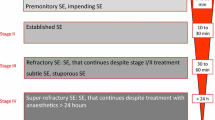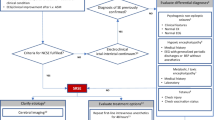Abstract
Tiagabine-related status epilepticus (SE) is an uncommon complication of tiagabine use. We aimed to detail the features and outcomes in a patient with tiagabine poisoning and review the relevant literature. We describe a case of tiagabine-related SE and literature review based on a 1995–2019 PubMed search. We report the case of a 30-year-old man with super-refractory SE after tiagabine poisoning. He fully recovered after 72 h of general anesthesia and was discharged from the ICU on day 16. A literature review showed distinct features among patients with tiagabine-related SE. Tiagabine side effects were characterized by non-convulsive SE after a slight increase in tiagabine dose and a rapid favorable evolution after benzodiazepine and early tiagabine withdrawal. Generalized convulsive SE was a complication of voluntary or involuntary tiagabine poisoning and was particularly refractory. Both presentations are characterized by a return to baseline after prompt and adequate management. Tiagabine-related SE electroclinical features vary according to the underlying pathophysiological mechanism and can be life threatening. Recovery is the rule after tiagabine withdrawal and SE management with progressive therapeutic escalation guided by response to prior anticonvulsant treatments.

Similar content being viewed by others
Notes
https://www.R-project.org. Accessed September 16, 2019.
Abbreviations
- SE:
-
Status epilepticus
- ICU:
-
Intensive care unit
- GABA:
-
Gamma-aminobutyric acid
- GAT-1:
-
GABA transporter 1
- IQR:
-
Interquartile range
- EEG:
-
Electroencephalogram
- NCSE:
-
Non-convulsive status epilepticus
- CSE:
-
Convulsive status epilepticus
- 5-HT2:
-
5-Hydroxytryptamine 2
- GCSE:
-
Generalized convulsive status epilepticus
References
Sveinbjornsdottir S, Sander JW, Patsalos PN et al (1994) Neuropsychological effects of tiagabine, a potential new antiepileptic drug. Seizure 3:29–35
Rosenthal M (2003) Tiagabine for the treatment of generalized anxiety disorder: a randomized, open-label, clinical trial with paroxetine as a positive control. J Clin Psychiatry 64:1245–1249
Vinton A, Kornberg AJ, Cowley M et al (2005) Tiagabine-induced generalised non convulsive status epilepticus in patients with lesional focal epilepsy. J Clin Neurosci 12:128–133. https://doi.org/10.1016/j.jocn.2004.03.027
Haddad NI, Umashankar G, Harik SI (2007) Tiagabine-induced non-convulsive status epilepticus in a patient without history of epilepsy. Neurosciences (Riyadh) 12:152–154
Leikin JB, Benigno J, Dubow JS, Fisher M (2008) Status epilepticus due to tiagabine ingestion. Am J Ther 15:290. https://doi.org/10.1097/MJT.0b013e31815b04d4
Vollmar C, Noachtar S (2007) Tiagabine-induced myoclonic status epilepticus in a nonepileptic patient. Neurology 68:310. https://doi.org/10.1212/01.wnl.0000252370.51970.07
Skodda S, Kramer I, Spittler JF, Gehlen W (2001) Non-convulsive status epilepticus in two patients receiving tiagabine add-on treatment. J Neurol 248:109–112. https://doi.org/10.1007/s004150170244
Imperiale D, Pignatta P, Cerrato P et al (2003) Nonconvulsive status epilepticus due to a de novo contralateral focus during tiagabine adjunctive therapy. Seizure 12:319–322
Fitzek S, Hegemann S, Sauner D et al (2001) Drug-induced nonconvulsive status epilepticus with low dose of tiagabine. Epileptic Disord 3:147–150
Zhu Y, Vaughn BV (2002) Non-convulsive status epilepticus induced by tiagabine in a patient with pseudoseizure. Seizure 11:57–59. https://doi.org/10.1053/seiz.2001.0560
Trinka E, Moroder T, Nagler M et al (1999) Clinical and EEG findings in complex partial status epilepticus with tiagabine. Seizure 8:41–44. https://doi.org/10.1053/seiz.1998.0223
Knake S, Hamer HM, Schomburg U et al (1999) Tiagabine-induced absence status in idiopathic generalized epilepsy. Seizure 8:314–317. https://doi.org/10.1053/seiz.1999.0303
Eckardt KM, Steinhoff BJ (1998) Nonconvulsive status epilepticus in two patients receiving tiagabine treatment. Epilepsia 39:671–674
Ostrovskiy D, Spanaki MV, Morris GL (2002) Tiagabine overdose can induce convulsive status epilepticus. Epilepsia 43:773–774. https://doi.org/10.1046/j.1528-1157.2002.51601.x
Schapel G, Chadwick D (1996) Tiagabine and non-convulsive status epilepticus. Seizure 5:153–156. https://doi.org/10.1016/S1059-1311(96)80111-7
Jette N, Cappell J, VanPassel L, Akman CI (2006) Tiagabine-induced nonconvulsive status epilepticus in an adolescent without epilepsy. Neurology 67:1514–1515. https://doi.org/10.1212/01.wnl.0000223336.07466.f3
Cantrell FL, Ritter M, Himes E (2004) Intentional overdose with tiagabine: an unusual clinical presentation. J Emerg Med 27:271–272. https://doi.org/10.1016/j.jemermed.2004.06.003
Forbes RA, Kalra H, Hackett LP, Daly FF (2007) Deliberate self-poisoning with tiagabine: an unusual toxidrome. Emerg Med Australas 19:556–558. https://doi.org/10.1111/j.1742-6723.2007.00973.x
Kellinghaus C, Dziewas RWW-U, Lüdemann PG (2002) Tiagabine-related non-convulsive status epilepticus in partial epilepsy: three case reports and a review of the literature. Seizure 11:243–249. https://doi.org/10.1053/seiz.2001.0594
Ettinger AB, Bernal OG, Andriola MR et al (1999) Two cases of nonconvulsive status epilepticus in association with tiagabine therapy. Epilepsia 40:1159–1162
de Borchgrave V, Lienard F, Willemart Th, van Rijckevorsel K (2003) Clinical and EEG findings in six patients with altered mental status receiving tiagabine therapy. Epilepsy Behav 4:326–337. https://doi.org/10.1016/S1525-5050(03)00107-0
Brouns R, Van Paesschen W (2002) Recurrent complex partial status epilepticus associated with tiagabine rechallenge. Acta Neurol Belg 102:19–20
Skardoutsou A, Voudris KA, Vagiakou EA (2003) Non-convulsive status epilepticus associated with tiagabine therapy in children. Seizure 12:599–601. https://doi.org/10.1016/S1059-1311(03)00102-X
Mangano S, Cusumano L, Fontana A (2003) Non-convulsive status epilepticus associated with tiagabine in a pediatric patient. Brain Develop 25:518–521. https://doi.org/10.1016/S0387-7604(03)00028-7
Balslev T, Uldall P, Buchholt J (2000) Provocation of non-convulsive status epilepticus by tiagabine in three adolescent patients. Euro J Paediatr Neurol 4:169–170. https://doi.org/10.1053/ejpn.2000.0293
Piccinelli P, Borgatti R, Perucca E et al (2000) Frontal nonconvulsive status epilepticus associated with high-dose tiagabine therapy in a child with familial bilateral perisylvian polymicrogyria. Epilepsia 41:1485–1488. https://doi.org/10.1111/j.1528-1157.2000.tb00126.x
Fulton JA, Hoffman RS, Nelson LS (2005) Tiagabine overdose: a case of status epilepticus in a non-epileptic patient. Clin Toxicol 43:869–871. https://doi.org/10.1080/15563650500357586
Koepp MJ, Edwards M, Collins J et al (2005) Status epilepticus and tiagabine therapy revisited. Epilepsia 46:1625–1632. https://doi.org/10.1111/j.1528-1167.2005.00263.x
Azar NJ, Bangalore-Vittal N, Arain A, Abou-Khalil BW (2013) Tiagabine-induced stupor in patients with psychogenic nonepileptic seizures: nonconvulsive status epilepticus or encephalopathy? Epilepsy Behav 27:330–332. https://doi.org/10.1016/j.yebeh.2013.02.016
Hamandi K, Myers J, Muthukumaraswamy S (2014) Tiagabine-induced stupor—more evidence for an encephalopathy. Epilepsy Behav 31:196–197. https://doi.org/10.1016/j.yebeh.2013.12.027
Leach JP, Brodie MJ (1998) Tiagabine. Lancet 351:203–207. https://doi.org/10.1016/S0140-6736(97)05035-6
Chan PK, Yung WH (1999) Inhibitory postsynaptic currents of rat substantia nigra pars reticulata neurons: role of GABA receptors and GABA uptake. Brain Res 838:18–26. https://doi.org/10.1016/s0006-8993(99)01654-6
Jackson MF, Esplin B, Capek R (1999) Activity-dependent enhancement of hyperpolarizing and depolarizing gamma-aminobutyric acid (GABA) synaptic responses following inhibition of GABA uptake by tiagabine. Epilepsy Res 37:25–36
Acknowledgement
We thank the Centre Hospitalier de Versailles for editorial assistance.
Funding
We received no funds for this study.
Author information
Authors and Affiliations
Contributions
GH: conceived and designed the trial, collected data, analyzed and interpreted the data, wrote the first draft of the manuscript, and approved the final version of the manuscript. AF: collected data and approved the final version of the manuscript. SL: conceived, designed, and supervised the trial, coordinated data collection, analyzed and interpreted the data, wrote the first draft and final version of the manuscript.
Corresponding author
Ethics declarations
Conflict of interest
The authors have declared that there are no competing interests. Geoffroy Hariri: reports no financial relationships relevant to the study. Alexis Ferre: reports no financial relationships relevant to the study. Stephane Legriel: reports no financial relationships relevant to the study.
Ethical approval
All procedures performed in studies involving human participants were in accordance with the ethical standards of the institutional and national research committee and with the 1964 Helsinki declaration and its later amendments or comparable ethical standards.
Informed consent
For the case we report, informed consent was given by the family of the patient.
Additional information
Publisher's Note
Springer Nature remains neutral with regard to jurisdictional claims in published maps and institutional affiliations.
Rights and permissions
About this article
Cite this article
Hariri, G., Ferre, A. & Legriel, S. Tiagabine-related status epilepticus: a case report and systematic literature review. Acta Neurol Belg 120, 1283–1288 (2020). https://doi.org/10.1007/s13760-020-01464-6
Received:
Accepted:
Published:
Issue Date:
DOI: https://doi.org/10.1007/s13760-020-01464-6




